Strategic Analysis of Facebook: Mission, Forces, and Strategy
VerifiedAdded on 2023/03/17
|7
|1291
|27
Report
AI Summary
This report provides a strategic analysis of Facebook, examining its mission and vision statements, as well as its competitive environment using Porter's Five Forces model. The analysis of the competitive forces includes rivalry among firms, the bargaining power of suppliers and customers, the potential for new entrants, and the threat of substitute products or services. The report then focuses on Facebook's corporate-level strategies, including integration, diversification, and acquisition strategies. It highlights Facebook's horizontal integration through acquisitions like Instagram and WhatsApp, as well as its diversification efforts to provide new professional services. The report is based on the provided case study and external research, and it adheres to the assignment's word count and referencing requirements.

Strategic management
5/9/2019
Facebook
5/9/2019
Paraphrase This Document
Need a fresh take? Get an instant paraphrase of this document with our AI Paraphraser
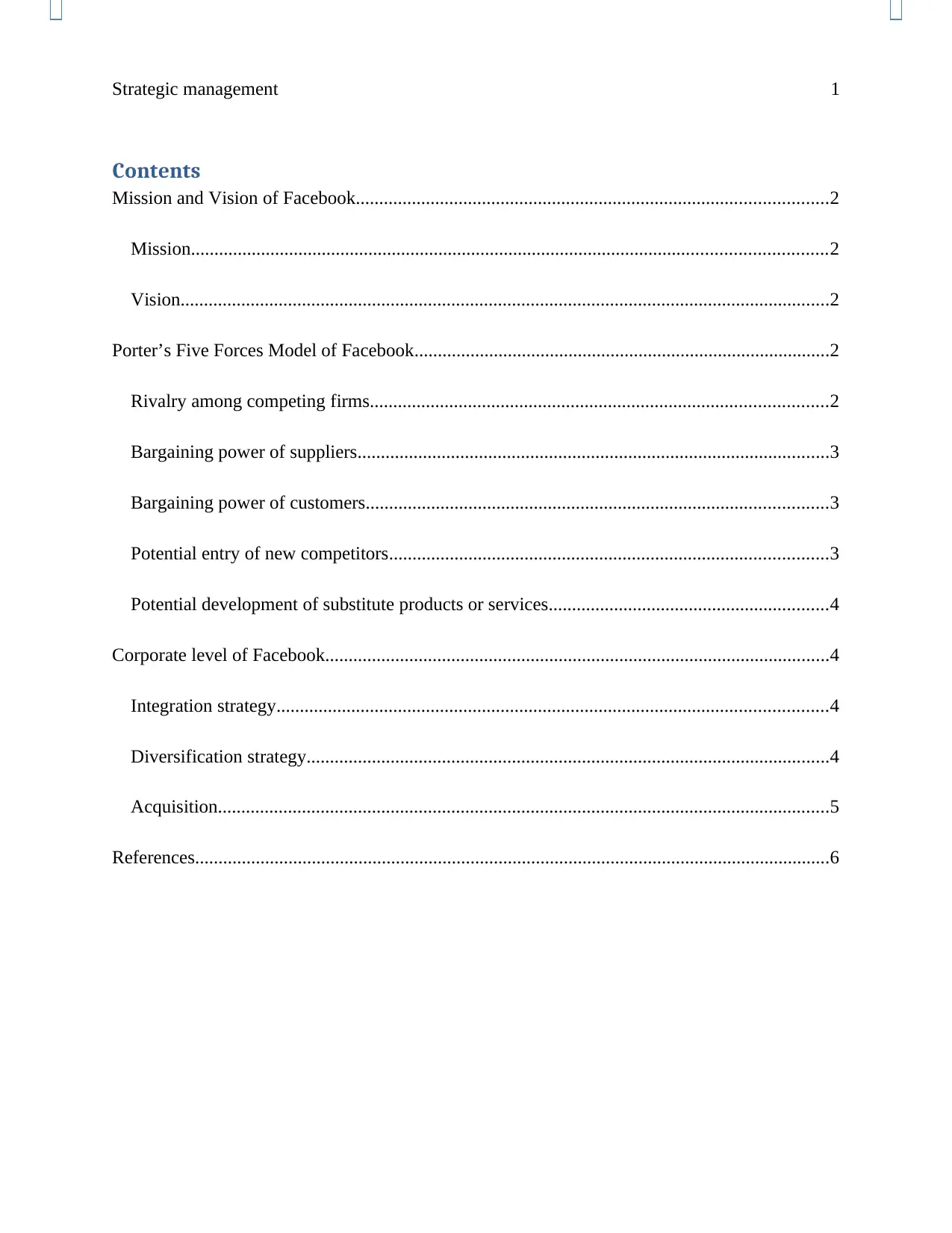
Strategic management 1
Contents
Mission and Vision of Facebook.....................................................................................................2
Mission........................................................................................................................................2
Vision...........................................................................................................................................2
Porter’s Five Forces Model of Facebook.........................................................................................2
Rivalry among competing firms..................................................................................................2
Bargaining power of suppliers.....................................................................................................3
Bargaining power of customers...................................................................................................3
Potential entry of new competitors..............................................................................................3
Potential development of substitute products or services............................................................4
Corporate level of Facebook............................................................................................................4
Integration strategy......................................................................................................................4
Diversification strategy................................................................................................................4
Acquisition...................................................................................................................................5
References........................................................................................................................................6
Contents
Mission and Vision of Facebook.....................................................................................................2
Mission........................................................................................................................................2
Vision...........................................................................................................................................2
Porter’s Five Forces Model of Facebook.........................................................................................2
Rivalry among competing firms..................................................................................................2
Bargaining power of suppliers.....................................................................................................3
Bargaining power of customers...................................................................................................3
Potential entry of new competitors..............................................................................................3
Potential development of substitute products or services............................................................4
Corporate level of Facebook............................................................................................................4
Integration strategy......................................................................................................................4
Diversification strategy................................................................................................................4
Acquisition...................................................................................................................................5
References........................................................................................................................................6
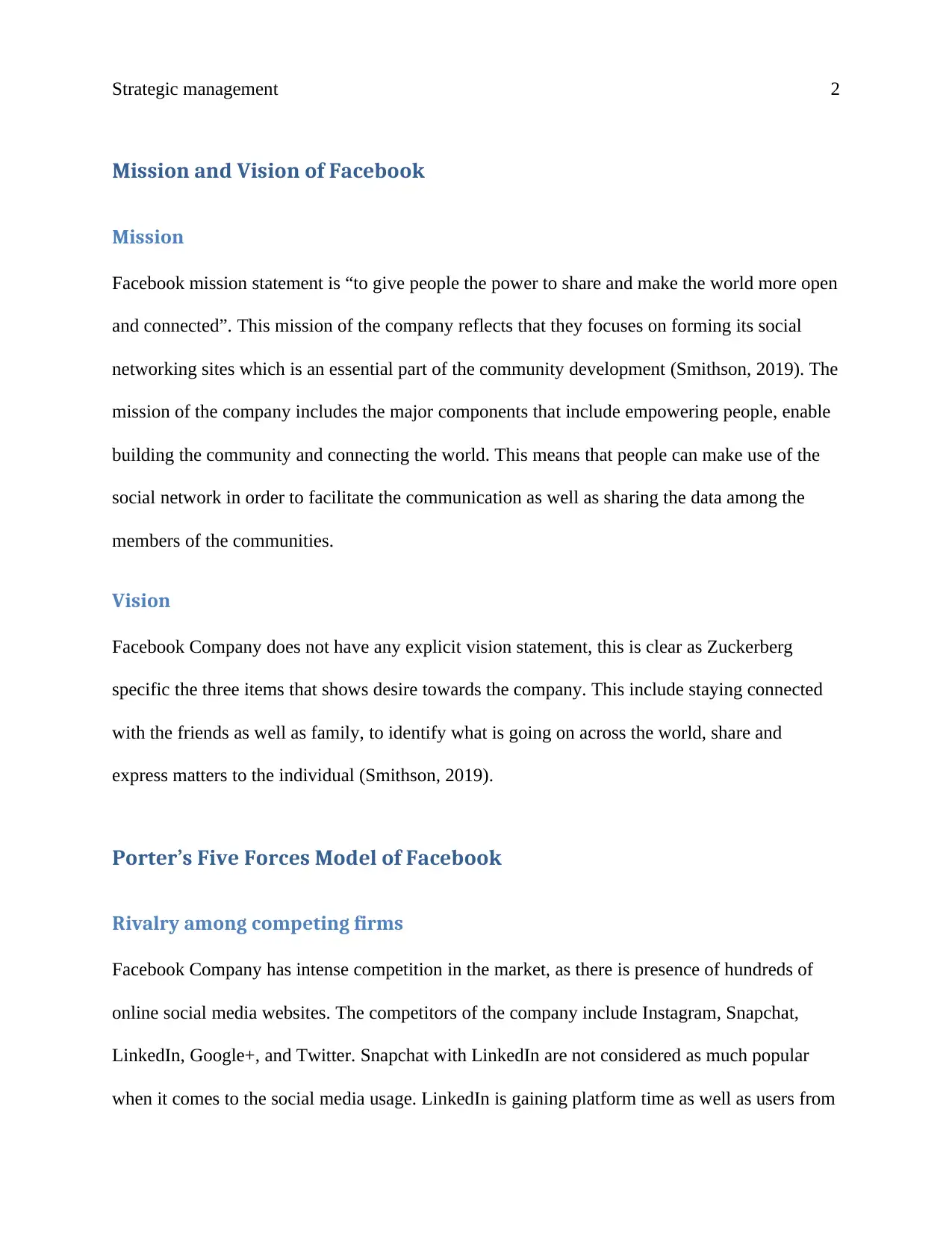
Strategic management 2
Mission and Vision of Facebook
Mission
Facebook mission statement is “to give people the power to share and make the world more open
and connected”. This mission of the company reflects that they focuses on forming its social
networking sites which is an essential part of the community development (Smithson, 2019). The
mission of the company includes the major components that include empowering people, enable
building the community and connecting the world. This means that people can make use of the
social network in order to facilitate the communication as well as sharing the data among the
members of the communities.
Vision
Facebook Company does not have any explicit vision statement, this is clear as Zuckerberg
specific the three items that shows desire towards the company. This include staying connected
with the friends as well as family, to identify what is going on across the world, share and
express matters to the individual (Smithson, 2019).
Porter’s Five Forces Model of Facebook
Rivalry among competing firms
Facebook Company has intense competition in the market, as there is presence of hundreds of
online social media websites. The competitors of the company include Instagram, Snapchat,
LinkedIn, Google+, and Twitter. Snapchat with LinkedIn are not considered as much popular
when it comes to the social media usage. LinkedIn is gaining platform time as well as users from
Mission and Vision of Facebook
Mission
Facebook mission statement is “to give people the power to share and make the world more open
and connected”. This mission of the company reflects that they focuses on forming its social
networking sites which is an essential part of the community development (Smithson, 2019). The
mission of the company includes the major components that include empowering people, enable
building the community and connecting the world. This means that people can make use of the
social network in order to facilitate the communication as well as sharing the data among the
members of the communities.
Vision
Facebook Company does not have any explicit vision statement, this is clear as Zuckerberg
specific the three items that shows desire towards the company. This include staying connected
with the friends as well as family, to identify what is going on across the world, share and
express matters to the individual (Smithson, 2019).
Porter’s Five Forces Model of Facebook
Rivalry among competing firms
Facebook Company has intense competition in the market, as there is presence of hundreds of
online social media websites. The competitors of the company include Instagram, Snapchat,
LinkedIn, Google+, and Twitter. Snapchat with LinkedIn are not considered as much popular
when it comes to the social media usage. LinkedIn is gaining platform time as well as users from
⊘ This is a preview!⊘
Do you want full access?
Subscribe today to unlock all pages.

Trusted by 1+ million students worldwide
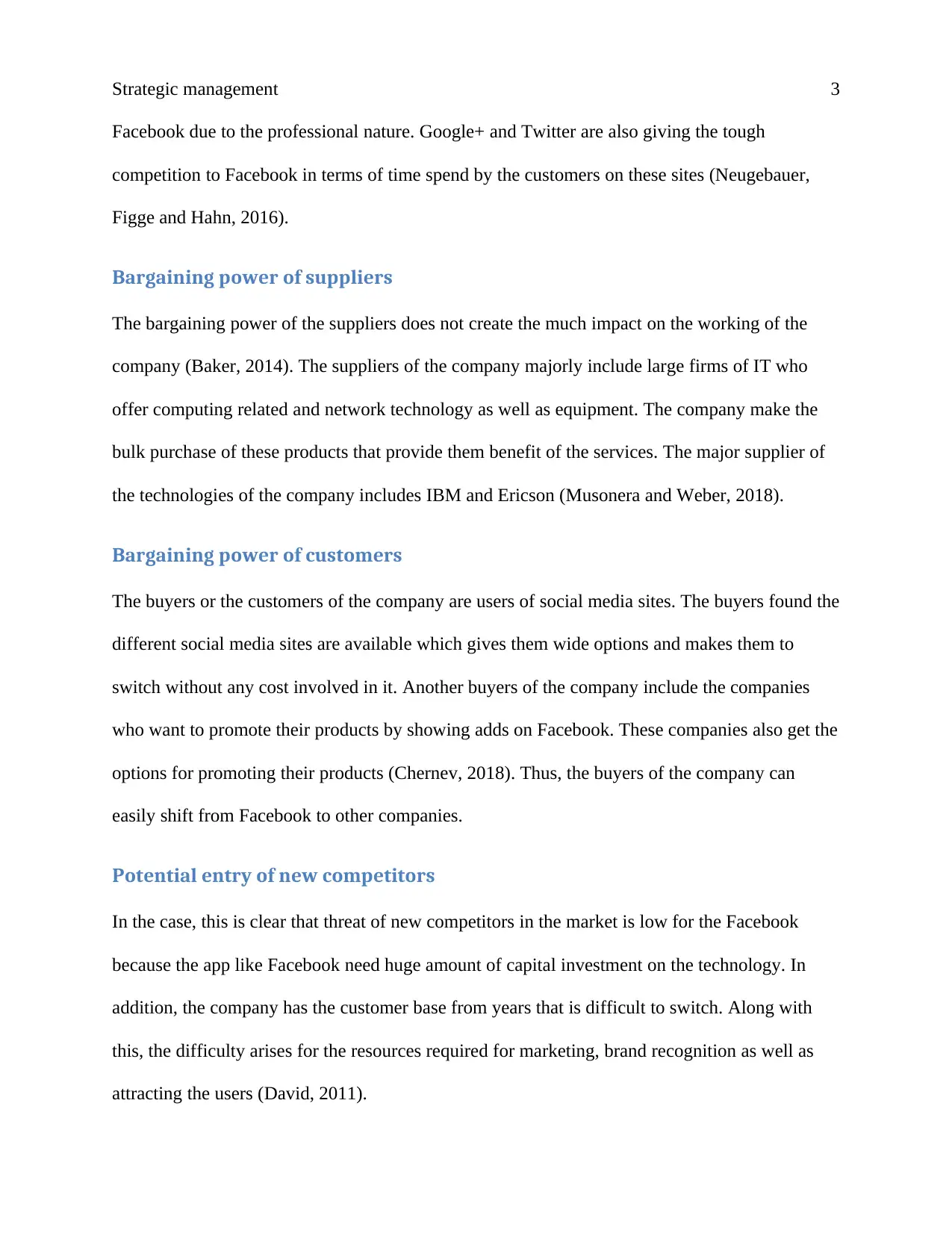
Strategic management 3
Facebook due to the professional nature. Google+ and Twitter are also giving the tough
competition to Facebook in terms of time spend by the customers on these sites (Neugebauer,
Figge and Hahn, 2016).
Bargaining power of suppliers
The bargaining power of the suppliers does not create the much impact on the working of the
company (Baker, 2014). The suppliers of the company majorly include large firms of IT who
offer computing related and network technology as well as equipment. The company make the
bulk purchase of these products that provide them benefit of the services. The major supplier of
the technologies of the company includes IBM and Ericson (Musonera and Weber, 2018).
Bargaining power of customers
The buyers or the customers of the company are users of social media sites. The buyers found the
different social media sites are available which gives them wide options and makes them to
switch without any cost involved in it. Another buyers of the company include the companies
who want to promote their products by showing adds on Facebook. These companies also get the
options for promoting their products (Chernev, 2018). Thus, the buyers of the company can
easily shift from Facebook to other companies.
Potential entry of new competitors
In the case, this is clear that threat of new competitors in the market is low for the Facebook
because the app like Facebook need huge amount of capital investment on the technology. In
addition, the company has the customer base from years that is difficult to switch. Along with
this, the difficulty arises for the resources required for marketing, brand recognition as well as
attracting the users (David, 2011).
Facebook due to the professional nature. Google+ and Twitter are also giving the tough
competition to Facebook in terms of time spend by the customers on these sites (Neugebauer,
Figge and Hahn, 2016).
Bargaining power of suppliers
The bargaining power of the suppliers does not create the much impact on the working of the
company (Baker, 2014). The suppliers of the company majorly include large firms of IT who
offer computing related and network technology as well as equipment. The company make the
bulk purchase of these products that provide them benefit of the services. The major supplier of
the technologies of the company includes IBM and Ericson (Musonera and Weber, 2018).
Bargaining power of customers
The buyers or the customers of the company are users of social media sites. The buyers found the
different social media sites are available which gives them wide options and makes them to
switch without any cost involved in it. Another buyers of the company include the companies
who want to promote their products by showing adds on Facebook. These companies also get the
options for promoting their products (Chernev, 2018). Thus, the buyers of the company can
easily shift from Facebook to other companies.
Potential entry of new competitors
In the case, this is clear that threat of new competitors in the market is low for the Facebook
because the app like Facebook need huge amount of capital investment on the technology. In
addition, the company has the customer base from years that is difficult to switch. Along with
this, the difficulty arises for the resources required for marketing, brand recognition as well as
attracting the users (David, 2011).
Paraphrase This Document
Need a fresh take? Get an instant paraphrase of this document with our AI Paraphraser
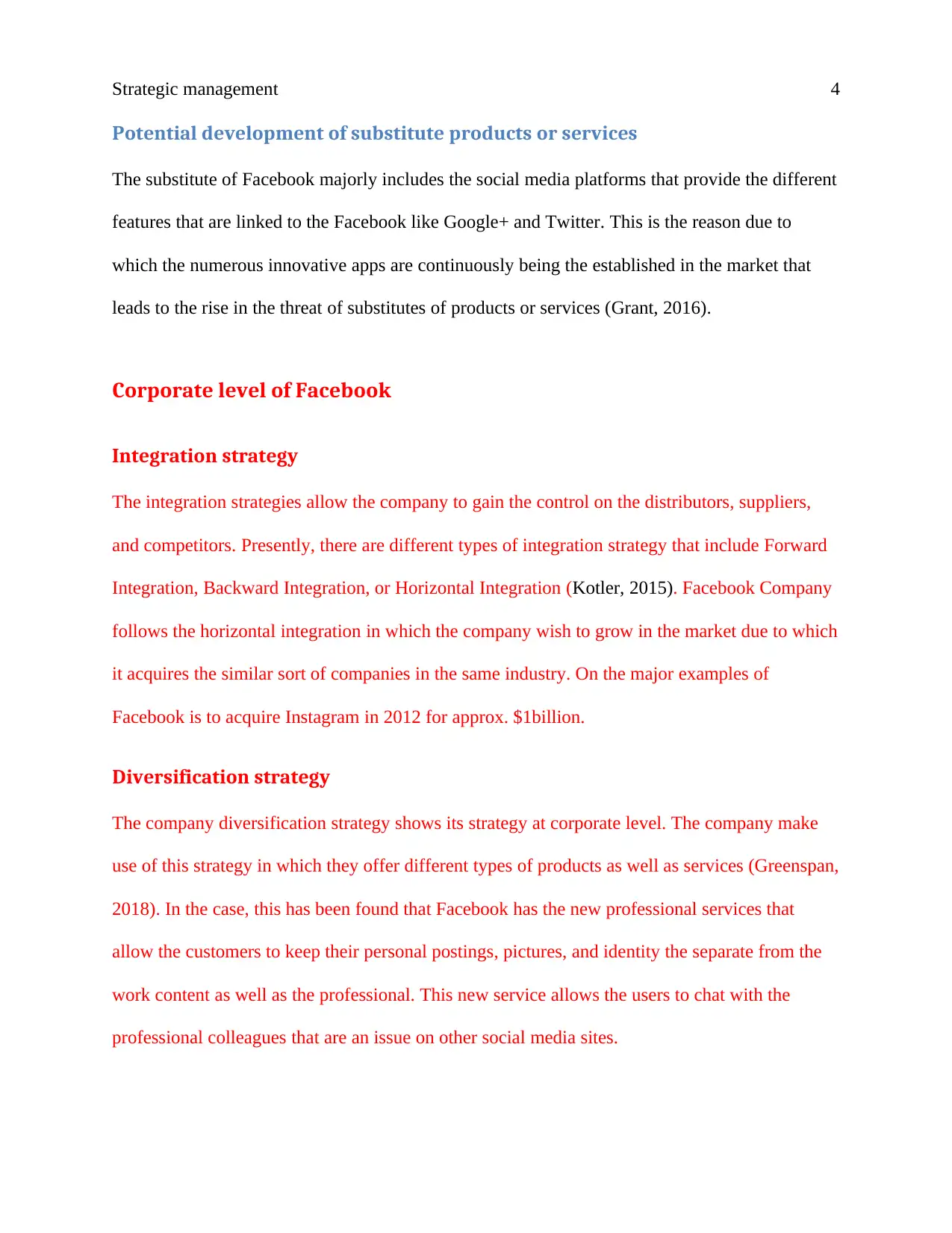
Strategic management 4
Potential development of substitute products or services
The substitute of Facebook majorly includes the social media platforms that provide the different
features that are linked to the Facebook like Google+ and Twitter. This is the reason due to
which the numerous innovative apps are continuously being the established in the market that
leads to the rise in the threat of substitutes of products or services (Grant, 2016).
Corporate level of Facebook
Integration strategy
The integration strategies allow the company to gain the control on the distributors, suppliers,
and competitors. Presently, there are different types of integration strategy that include Forward
Integration, Backward Integration, or Horizontal Integration (Kotler, 2015). Facebook Company
follows the horizontal integration in which the company wish to grow in the market due to which
it acquires the similar sort of companies in the same industry. On the major examples of
Facebook is to acquire Instagram in 2012 for approx. $1billion.
Diversification strategy
The company diversification strategy shows its strategy at corporate level. The company make
use of this strategy in which they offer different types of products as well as services (Greenspan,
2018). In the case, this has been found that Facebook has the new professional services that
allow the customers to keep their personal postings, pictures, and identity the separate from the
work content as well as the professional. This new service allows the users to chat with the
professional colleagues that are an issue on other social media sites.
Potential development of substitute products or services
The substitute of Facebook majorly includes the social media platforms that provide the different
features that are linked to the Facebook like Google+ and Twitter. This is the reason due to
which the numerous innovative apps are continuously being the established in the market that
leads to the rise in the threat of substitutes of products or services (Grant, 2016).
Corporate level of Facebook
Integration strategy
The integration strategies allow the company to gain the control on the distributors, suppliers,
and competitors. Presently, there are different types of integration strategy that include Forward
Integration, Backward Integration, or Horizontal Integration (Kotler, 2015). Facebook Company
follows the horizontal integration in which the company wish to grow in the market due to which
it acquires the similar sort of companies in the same industry. On the major examples of
Facebook is to acquire Instagram in 2012 for approx. $1billion.
Diversification strategy
The company diversification strategy shows its strategy at corporate level. The company make
use of this strategy in which they offer different types of products as well as services (Greenspan,
2018). In the case, this has been found that Facebook has the new professional services that
allow the customers to keep their personal postings, pictures, and identity the separate from the
work content as well as the professional. This new service allows the users to chat with the
professional colleagues that are an issue on other social media sites.
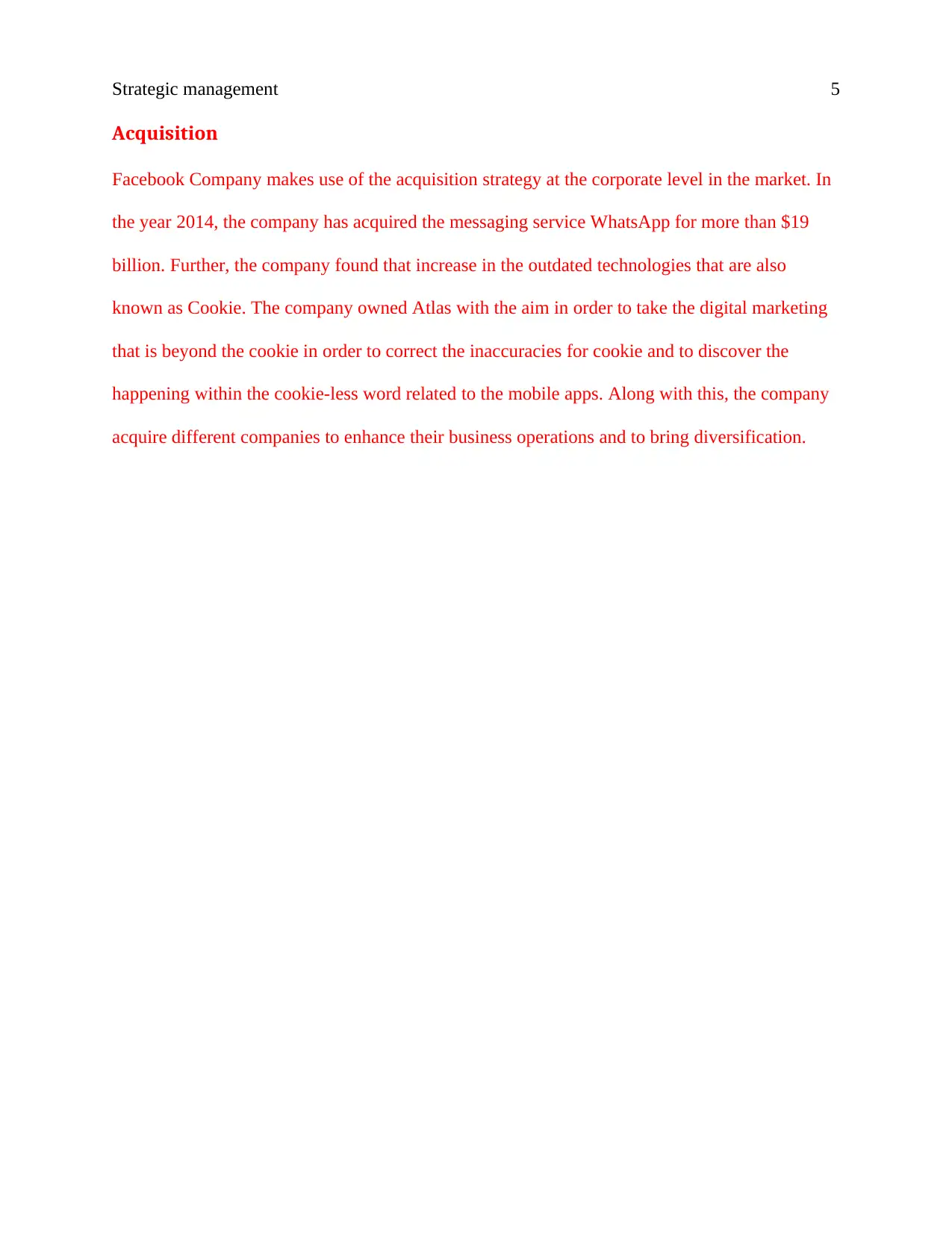
Strategic management 5
Acquisition
Facebook Company makes use of the acquisition strategy at the corporate level in the market. In
the year 2014, the company has acquired the messaging service WhatsApp for more than $19
billion. Further, the company found that increase in the outdated technologies that are also
known as Cookie. The company owned Atlas with the aim in order to take the digital marketing
that is beyond the cookie in order to correct the inaccuracies for cookie and to discover the
happening within the cookie-less word related to the mobile apps. Along with this, the company
acquire different companies to enhance their business operations and to bring diversification.
Acquisition
Facebook Company makes use of the acquisition strategy at the corporate level in the market. In
the year 2014, the company has acquired the messaging service WhatsApp for more than $19
billion. Further, the company found that increase in the outdated technologies that are also
known as Cookie. The company owned Atlas with the aim in order to take the digital marketing
that is beyond the cookie in order to correct the inaccuracies for cookie and to discover the
happening within the cookie-less word related to the mobile apps. Along with this, the company
acquire different companies to enhance their business operations and to bring diversification.
⊘ This is a preview!⊘
Do you want full access?
Subscribe today to unlock all pages.

Trusted by 1+ million students worldwide
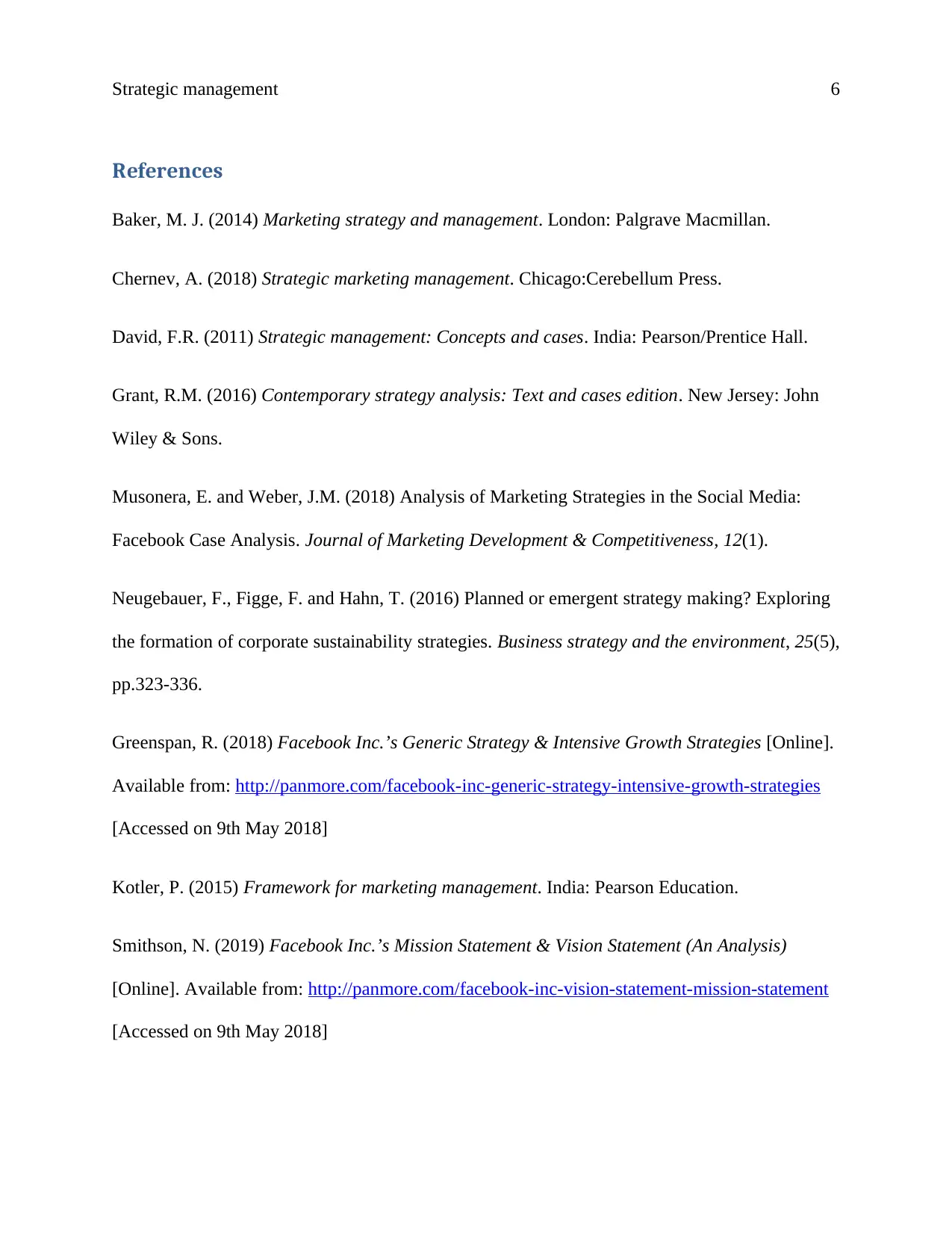
Strategic management 6
References
Baker, M. J. (2014) Marketing strategy and management. London: Palgrave Macmillan.
Chernev, A. (2018) Strategic marketing management. Chicago:Cerebellum Press.
David, F.R. (2011) Strategic management: Concepts and cases. India: Pearson/Prentice Hall.
Grant, R.M. (2016) Contemporary strategy analysis: Text and cases edition. New Jersey: John
Wiley & Sons.
Musonera, E. and Weber, J.M. (2018) Analysis of Marketing Strategies in the Social Media:
Facebook Case Analysis. Journal of Marketing Development & Competitiveness, 12(1).
Neugebauer, F., Figge, F. and Hahn, T. (2016) Planned or emergent strategy making? Exploring
the formation of corporate sustainability strategies. Business strategy and the environment, 25(5),
pp.323-336.
Greenspan, R. (2018) Facebook Inc.’s Generic Strategy & Intensive Growth Strategies [Online].
Available from: http://panmore.com/facebook-inc-generic-strategy-intensive-growth-strategies
[Accessed on 9th May 2018]
Kotler, P. (2015) Framework for marketing management. India: Pearson Education.
Smithson, N. (2019) Facebook Inc.’s Mission Statement & Vision Statement (An Analysis)
[Online]. Available from: http://panmore.com/facebook-inc-vision-statement-mission-statement
[Accessed on 9th May 2018]
References
Baker, M. J. (2014) Marketing strategy and management. London: Palgrave Macmillan.
Chernev, A. (2018) Strategic marketing management. Chicago:Cerebellum Press.
David, F.R. (2011) Strategic management: Concepts and cases. India: Pearson/Prentice Hall.
Grant, R.M. (2016) Contemporary strategy analysis: Text and cases edition. New Jersey: John
Wiley & Sons.
Musonera, E. and Weber, J.M. (2018) Analysis of Marketing Strategies in the Social Media:
Facebook Case Analysis. Journal of Marketing Development & Competitiveness, 12(1).
Neugebauer, F., Figge, F. and Hahn, T. (2016) Planned or emergent strategy making? Exploring
the formation of corporate sustainability strategies. Business strategy and the environment, 25(5),
pp.323-336.
Greenspan, R. (2018) Facebook Inc.’s Generic Strategy & Intensive Growth Strategies [Online].
Available from: http://panmore.com/facebook-inc-generic-strategy-intensive-growth-strategies
[Accessed on 9th May 2018]
Kotler, P. (2015) Framework for marketing management. India: Pearson Education.
Smithson, N. (2019) Facebook Inc.’s Mission Statement & Vision Statement (An Analysis)
[Online]. Available from: http://panmore.com/facebook-inc-vision-statement-mission-statement
[Accessed on 9th May 2018]
1 out of 7
Related Documents
Your All-in-One AI-Powered Toolkit for Academic Success.
+13062052269
info@desklib.com
Available 24*7 on WhatsApp / Email
![[object Object]](/_next/static/media/star-bottom.7253800d.svg)
Unlock your academic potential
Copyright © 2020–2025 A2Z Services. All Rights Reserved. Developed and managed by ZUCOL.





